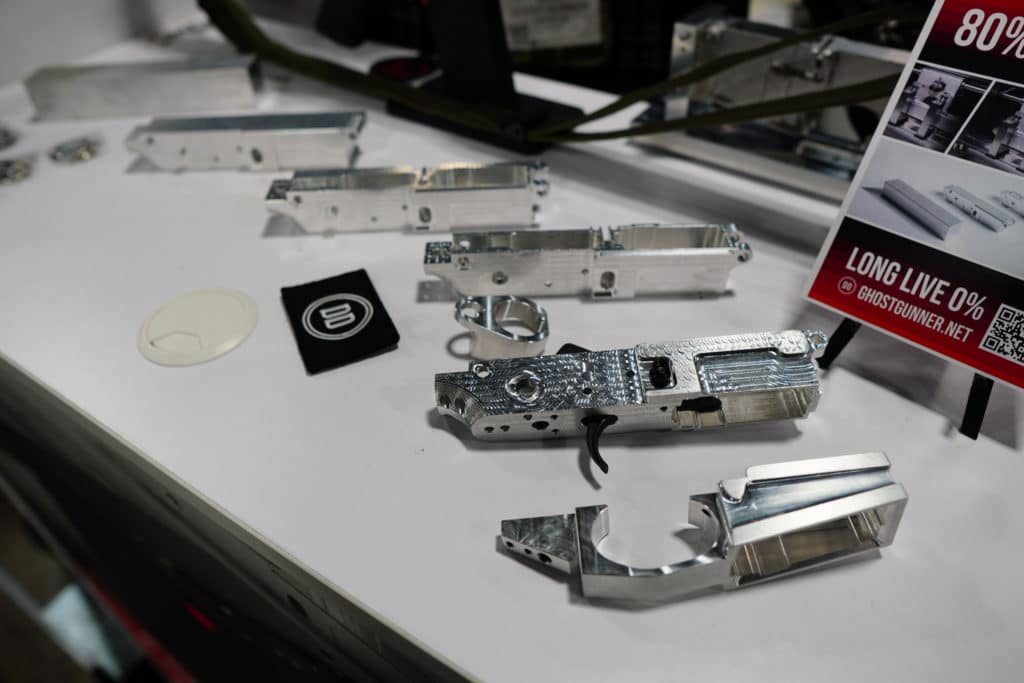We focused quite a bit on President Biden’s shakeup of the ATF. We broke the news it was coming. And we were the first to report on the backlash to it.
However, the President did more than just shuffle around ATF leadership in his latest push for new gun restrictions. He also released the final version of the ATF’s “ghost gun” kit ban. But the rule is 346 pages long. So, I read through it and gave insight into what it really does.
Biden is also facing some new pushback from his own party. This week, the top Democrat in Florida filed a gun-rights lawsuit against the Biden Administration. Contributing Writer Jake Fogleman examines what’s going on and how it might be a viable model for other vulnerable Democrats to follow.
Plus, Cam Edwards joins the podcast to dive into the political fallout of what President Biden did with the ATF.

Analysis: What’s in Biden’s ‘Ghost Gun’ Kit Ban [Member Exclusive]
By Stephen Gutowski
The first of President Joe Biden’s (D.) significant gun-control executive actions has been finalized.
A rule redefining what constitutes a firearm under federal law to expand the ATF’s power was published last week. The President and gun-control advocates have championed the rule as a necessary step to cracking down on unserialized “ghost guns” that have increasingly shown up at crime scenes. The NRA and the gun industry have derided the rule as ineffective at fighting crime and onerous for law-abiding gun owners.
So, what does the rule actually do?
Well, the core of the rule hasn’t changed a lot since The Reload published a leaked draft of the document last year. The ATF has modified significant portions and clarified others, though. They’ve pulled back in some ways but expanded their theoretical authority a great deal. Here is an outline of the most important aspects of the rule.
Expanding the ATF’s Power to Determine What is a Receiver or Frame
The most significant change is in vastly expanding the definition of what could constitute a regulatable “firearm” under federal law. While this hasn’t gotten nearly as much attention in the political sphere, it is really the core of this new rule. That’s because, in recent years, the ATF and Department of Justice have run into legal trouble over how they’ve long applied the definition of “firearm.”
Because the previous definition required a gun part to include both the firing mechanism and the hammer or bolt in order to be regulated as a frame or receiver, many popular firearms couldn’t be said to actually have one. The ATF long got around this by simply declaring a part that didn’t fit the official definition to be a gun’s frame or receiver.
The AR-15 is a perfect example of this phenomenon. It features a split receiver where the part that houses the firing mechanism is different from the one that houses the bolt. The ATF still determined the AR’s lower receiver was a receiver under the old definition and regulated it as such for decades.
In recent years, judges have grown skeptical of this workaround. Cases have been dropped because of it. The ATF’s top priority in this rule is fixing that problem.
So, they expanded the definition of firearm. Instead of needing both the fire control group and the bolt in the same piece, now only one is required. That solves the regulatory problem. But it also expands the ATF’s power to regulate what constitutes a firearm.
Under the new rule, guns could theoretically have more than one frame or receiver. That could mean the parts would have to be sold with serial numbers and background checks as if they were completed guns.
However, the ATF promises in the rule it will not do that with any guns currently on the market and only on specialized guns with unique receiver designs in the future. Instead, the ATF wants to effectively continue business as usual. The AR-15 is again a good example of this.
The new rule splits up handguns, shotguns, and rifles for their own definitions. The receiver on rifles are supposed to be the part which holds the bolt. The AR-15’s bolt is housed in the upper portion of its receiver. However, the ATF has traditionally determined the lower portion of the AR’s reciever to be the regulated “firearm” under federal law and the agency says it won’t change that determination.
The ATF is painting the expansion of the agency’s power as something that was necessary to continue regulating many guns at all. And as one that will maintain business as normal. Of course, just because the agency isn’t yet stretching the new limits of this definition right away doesn’t mean they won’t ever do it.
Banning “Ghost Gun” Kits
The other aspect of the definition change in the rule deals with an even greater expansion of the ATF’s authority. This time into the territory of determining what’s “readily convertible” into a firearm frame or receiver. The target is unfinished and unserialized “ghost guns.”
This is, of course, the aspect of the rule that’s gotten most of the attention.
The power the ATF is granting themselves is again quite broad. The line between unfinished parts that are “readily convertible” and those that aren’t is pretty vague under the rule. One footnote included in the rule provides an example where a part that could be completed in eight hours with access to a machine shop could be considered “readily convertible.”
With receivers for firearms like the AR-15, that could mean metal blocks are technically “readily convertible” to a finished receiver if sold with that purpose in mind.
But, again, the ATF is saying its plans to use this expansive power are much more limited. For one, they explicitly say they won’t regulate raw materials like metal blocks or plastic filaments. The ATF also goes out of its way to say that unfinished AR-15 lower receivers, commonly referred to as 80% lowers, remain outside the reach of regulation.
“ATF has maintained and continues to maintain that a partially complete frame or receiver alone is not a frame or receiver if it still requires performance of certain machining operations (e.g., milling out the fire control cavity of an AR-15 billet or blank, or indexing for that operation) because it may not readily be completed to house or hold the applicable fire control components,” the agency said in the rule.
Instead of taking an aggressive new tact towards unfinished gun parts, the agency says it wants to focus on what it has already been doing. Namely, it wants to go after “ghost gun” kits. The agency already raided a major manufacturer of unfinished parts back in 2020.
Now, it is expanding what qualifies as a “ghost gun” kit. Instead of going after kits with every part needed to finish the receiver and build it into a gun, it’s now going after unfinished parts sold alongside just a jig to help the customer make the right cuts to finish the part. It seems the agency may even consider the same company selling an unfinished receiver and a jig to the same customer in different transactions as a kit.
“A partially complete billet or blank of a frame or receiver is a ‘frame or receiver’ when it is sold, distributed, or possessed with a compatible jig or template, allowing a person using online instructions and common hand tools to complete the frame or receiver efficiently, quickly, and easily ‘to function as a frame or receiver,’ a term which is also explained in the final rule,” the ATF said in the rule.
And, even though it specified unfinished AR receivers are not regulated “firearms” until they are finished, the agency is still requiring companies that sell unfinished receivers to resubmit their products alongside any jigs and written instructions they might provide for reconsideration. This is all bound to draw lawsuits that question the rule on not just Second Amendment grounds, but also First Amendment ones. The legal fights are likely to stretch out for years in the same way the battle over the bump stock ban has dragged on.
Homemade Guns Are Transferable, Even Sellable
Somewhat surprisingly, the rule also explicitly states that homemade guns (which they call Privately Made Firearms or PMFs) are legal to both make and sell. The ATF points out that people who are not otherwise prohibited from possessing guns due to a disqualifying criminal or mental health record can legally build them in most states. They can even give or sell them to other people depending on the circumstances.
They don’t need to engrave their own serial numbers either.
That’s because the Gun Control Act, which is what the ATF is deriving its authority from, does not regulate private gun making. It only regulates commercial manufacturing and dealing. So long as you don’t make and sell enough guns to be considered “in the business” of making or selling guns, you don’t need to get a license for what you’re doing or add serial numbers to your guns.
“The final rule does not mandate unlicensed persons to mark their own PMFs for personal use, or when they occasionally acquire them for a personal collection or sell or transfer them from a personal collection to unlicensed in-State residents consistent with Federal, State, and local law,” the ATF said in the rule.
However, the rule does lay out a requirement for licensed gun dealers. If they take a PMF into their inventory, they have to add a serial number to it. The rule details how to mark the guns.
But the interesting part is the ATF has often worked on casting a cloud of doubt over what it might mean to be “in the business” of making or selling guns. At points, they have insisted selling even one gun under certain circumstances could require a federal license.
So, seeing the ATF come out and say it is legal to not just build your own guns but even sell them is pretty fascinating. Even if it is in line with what federal law allows.
Increasing How Long Gun Dealers Have to Keep Background Check Records
If the PMF serialization requirement sounds like extra work, mainly for licensed dealers, that’s because it is. The same is true for the new record-keeping requirements in the rule.
The FBI’s National Instant Criminal Background Check System (NICS) is designed to avoid creating a federal registry of guns since a registry is illegal under federal law. So, when somebody buys a gun and the FBI runs the details of the purchase through its system to determine whether or not they are prohibited from buying guns, the FBI doesn’t keep a record of that successful check. Instead, the FBI’s copies are required to be purged after 24 hours.
Up to now, licensed dealers have been required to hold on to those same checks for 20 years in order to help criminal gun-tracing efforts. If the dealer goes out of business, they are then required to turn over their NICS records to the ATF.
The new rule would extend that timetable indefinitely. Instead of holding on to NICS records for 20 years, dealers will have to hold on to them forever.
Additionally, the new process means the ATF will inevitably end up with far more NICS records recovered from out-of-business dealers. That’s something that has the industry perturbed since it will burden gun dealers with extra business costs. It has also prompted Republican Senators to cry foul and accuse the ATF of trying to create a federal registry of guns.
Reducing Silencer Regulation
The rule isn’t all about implementing more burdens on gun owners and the industry, though. The ATF is also seeking to reduce the amount of paperwork and regulation involved in silencer manufacturing, dealing, and ownership. Instead of treating every part of a silencer, often called suppressors, the same as a fully completed and functional silencer, the ATF wants to pick just the outer tube as the regulated part.
“Marking requirements have caused confusion and concern among many silencer manufacturers over the years,” the agency said in the rule. “The NPRM explained that some silencer parts defined as ‘silencers,’ such as baffles, are difficult for manufacturers to mark and listed examples of the ATF forms that manufacturers would have difficult filing and processing in a timely manner. The Department also explained that it makes little sense to mark all silencer parts for tracing purposes when the outer tube or housing of the complete device is marked and registered.”
This means much less paperwork and fewer headaches for silencer owners. There will no longer be hoops to jump through if you want to replace a wipe or a baffle.
Rule Adoption
While President Biden announced the rule last week, it has actually yet to be published in the federal registry, which is what really matters. Once it is published, it will likely face multiple gun-rights lawsuits that could delay its implementation for years or even kill it. The story of the President’s first major gun restrictions is far from over.
Podcast: Cam Edwards on President Biden’s Controversial ATF Moves [Member Early Access]
By Stephen Gutowski
Cam Edwards of Bearing Arms joins the show this week after the ATF saw a significant shakeup.
After President Biden announced he would nominate a new permanent director last week, he took to punishing the acting director. Marvin Richardson, a 30-year career agent, was moved down to acting deputy director for the last few months of his time at the agency. The move comes just a month after gun-control advocates and The New York Times attacked Richardson as too friendly towards the gun industry.
Cam argues those complaints were weak. He says the gun-control groups want an ideologue in charge of the ATF which is why they backed David Chipman’s failed nomination and are backing the nominations of Steve Dettelbach. He said Richardson fell short in their eyes, and ultimately the President’s, by not approaching the gun industry as an adversary.
But Cam sees the move to demote Richardson as one that will ultimately harm the President’s latest ATF nominee’s chances of getting through confirmation. He noted complaints from the National African American Gun Association about Richardson, who is Black, being passed over twice for White candidates whose most recent experience was in the political realm rather than law enforcement. Given how difficult it is to confirm an ATF director in an evenly divided Senate, and the fact Biden already failed to do so once before, any additional controversy could sink Dettebach’s bid.
Plus, Contributing Writer Jake Fogleman and I discuss a top Florida Democrat’s new gun-rights lawsuit against the Biden Administration.
You can listen to the show on your favorite podcasting app or by clicking here.
The video podcast is also available on our YouTube channel.

Analysis: Are Democrats Starting to Soften on Guns? [Member Exclusive]
By Jake Fogleman
This week saw the unexpected filing of a gun-rights lawsuit against the Biden administration.
Florida commissioner of agriculture Nikki Fried (D.) launched her challenge on Wednesday by alleging that current federal law prohibiting state-licensed medical marijuana users from owning guns violates the Second Amendment.
“I’m suing the Biden Administration because people’s rights are being limited,” Fried said of her lawsuit. “Medical marijuana is legal. Guns are legal. This is about people’s rights and their freedoms to responsibly have both.”
The move could be evidence that bleak electoral prospects and shifts in public opinion on guns are starting to affect some Democrats running for office.
Fried was pilloried on Twitter following the announcement of her suit by other progressives. But as many politicians have had to learn in recent years, Twitter is not real life. And the fact of the matter is, voters in real life have become more receptive to gun rights.
Multiple polls dating back to November 2021 have shown that registered voters currently prefer Republicans over Democrats on the issue of gun policy. Due to the ideological sorting between the two parties on the issue of guns in our current era, that essentially amounts to a statement against gun control.
And indeed, several other polls have found that sentiment to be accurate among voters in more explicit terms. A November Gallup poll found Americans’ support for stricter gun control was at its lowest level since 2014. Likewise, a Quinnipiac poll from the same time period found more Americans say they oppose gun control than support it. And just last month, a survey conducted by the University of Chicago confirmed that the surge in pandemic first-time gun buyers carried with it a surge in new gun owners who support liberalizing gun laws.
It should come as no surprise then that at least some Democratic politicians would start to read the room and soften their stance on gun control. This is especially true given the electoral momentum currently behind Republicans heading into election season.
The significance of the shift should not be overstated, however. While herself a progressive Democrat, Fried is seeking to unseat a relatively popular incumbent Republican governor in a state that has trended red over the last several years. Her suit could easily be interpreted as a campaign tactic to appeal to pro-gun moderates while still trying to hold on to her progressive bona fides by tying the suit to liberalized marijuana policy. It’s unlikely that Fried will soon adopt a broader pro-gun stance.
In fact, her suit itself made clear that she still generally supports gun-control policies.
“The Plaintiffs do not challenge the United States’ right to enact reasonable gun regulations that protect the public,” the suit reads. “In fact, the Plaintiffs are all strong advocates for reasonable gun regulations that keep firearms out of the hands of those who cannot safely possess them.”
Nevertheless, it is still noteworthy that a progressive Democrat who enjoys endorsements and financial support from Everytown for Gun Safety would file a Second Amendment lawsuit against a sitting Democratic presidential administration. This is especially true given the timing of the suit. It was filed just one week after President Biden delivered gun-control activists a big win by nominating a new permanent ATF director and releasing his administration’s new “ghost gun” kit ban.
Fried tying the Second Amendment suit to another cause typically favored by progressives could provide a model for other vulnerable Democrats to follow. Whether they decide to follow her lead could significantly impact the outcome of the midterm elections.
That’s it for now.
I’ll talk to you all again soon.
Thanks,
Stephen Gutowski
Founder
The Reload







